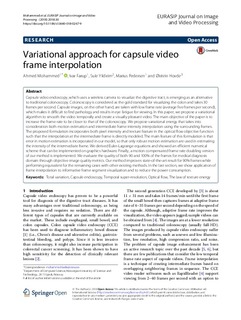| dc.contributor.author | Mohammed, Ahmed Kedir | |
| dc.contributor.author | Farup, Ivar | |
| dc.contributor.author | Yildirim, Sule | |
| dc.contributor.author | Pedersen, Marius | |
| dc.contributor.author | Hovde, Øistein | |
| dc.date.accessioned | 2018-05-02T14:31:37Z | |
| dc.date.available | 2018-05-02T14:31:37Z | |
| dc.date.created | 2018-04-17T10:05:51Z | |
| dc.date.issued | 2018 | |
| dc.identifier.citation | EURASIP Journal on Image and Video Processing. 2018, 1-13. | nb_NO |
| dc.identifier.issn | 1687-5176 | |
| dc.identifier.uri | http://hdl.handle.net/11250/2496846 | |
| dc.description.abstract | Capsule video endoscopy, which uses a wireless camera to visualize the digestive tract, is emerging as an alternative to traditional colonoscopy. Colonoscopy is considered as the gold standard for visualizing the colon and takes 30 frames per second. Capsule images, on the other hand, are taken with low frame rate (average five frames per second), which makes it difficult to find pathology and results in eye fatigue for viewing. In this paper, we propose a variational algorithm to smooth the video temporally and create a visually pleasant video. The main objective of the paper is to increase the frame rate to be closer to that of the colonoscopy. We propose variational energy that takes into consideration both motion estimation and intermediate frame intensity interpolation using the surrounding frames. The proposed formulation incorporates both pixel intensity and texture feature in the optical flow objective function such that the interpolation at the intermediate frame is directly modeled. The main feature of this formulation is that error in motion estimation is incorporated in our model, so that only robust motion estimation are used in estimating the intensity of the intermediate frame. We derived Euler-Lagrange equations and showed an efficient numerical scheme that can be implemented on graphics hardware. Finally, a motion compensated frame rate doubling version of our method is implemented. We evaluate the quality of both 90 and 100% of the frames for medical diagnosis domain through objective image quality metrics. Our method improves state-of-the-art result for 90% frames while performing equivalent for the remaining cases with other existing methods. In the last section, we show application of frame interpolation to informative frame segment visualization and to reduce the power consumption. | nb_NO |
| dc.language.iso | eng | nb_NO |
| dc.publisher | SpringerOpen | nb_NO |
| dc.relation.uri | https://doi.org/10.1186/s13640-018-0267-9 | |
| dc.rights | Navngivelse 4.0 Internasjonal | * |
| dc.rights.uri | http://creativecommons.org/licenses/by/4.0/deed.no | * |
| dc.title | Variational Approach for Capsule Video Frame Interpolation | nb_NO |
| dc.type | Journal article | nb_NO |
| dc.type | Peer reviewed | nb_NO |
| dc.description.version | publishedVersion | nb_NO |
| dc.source.pagenumber | 1-13 | nb_NO |
| dc.source.journal | EURASIP Journal on Image and Video Processing | nb_NO |
| dc.identifier.doi | https://doi.org/10.1186/s13640-018-0267-9 | |
| dc.identifier.cristin | 1579716 | |
| dc.relation.project | Norges forskningsråd: 536564 | nb_NO |
| dc.description.localcode | © The Author(s). 2018 Open Access This article is distributed under the terms of the Creative Commons Attribution 4.0 International License (http://creativecommons.org/licenses/by/4.0/), which permits unrestricted use, distribution, and reproduction in any medium, provided you give appropriate credit to the original author(s) and the source, provide a link to the Creative Commons license, and indicate if changes were made | nb_NO |
| cristin.unitcode | 194,63,10,0 | |
| cristin.unitcode | 194,63,30,0 | |
| cristin.unitname | Institutt for datateknologi og informatikk | |
| cristin.unitname | Institutt for informasjonssikkerhet og kommunikasjonsteknologi | |
| cristin.ispublished | true | |
| cristin.fulltext | original | |
| cristin.qualitycode | 1 | |

